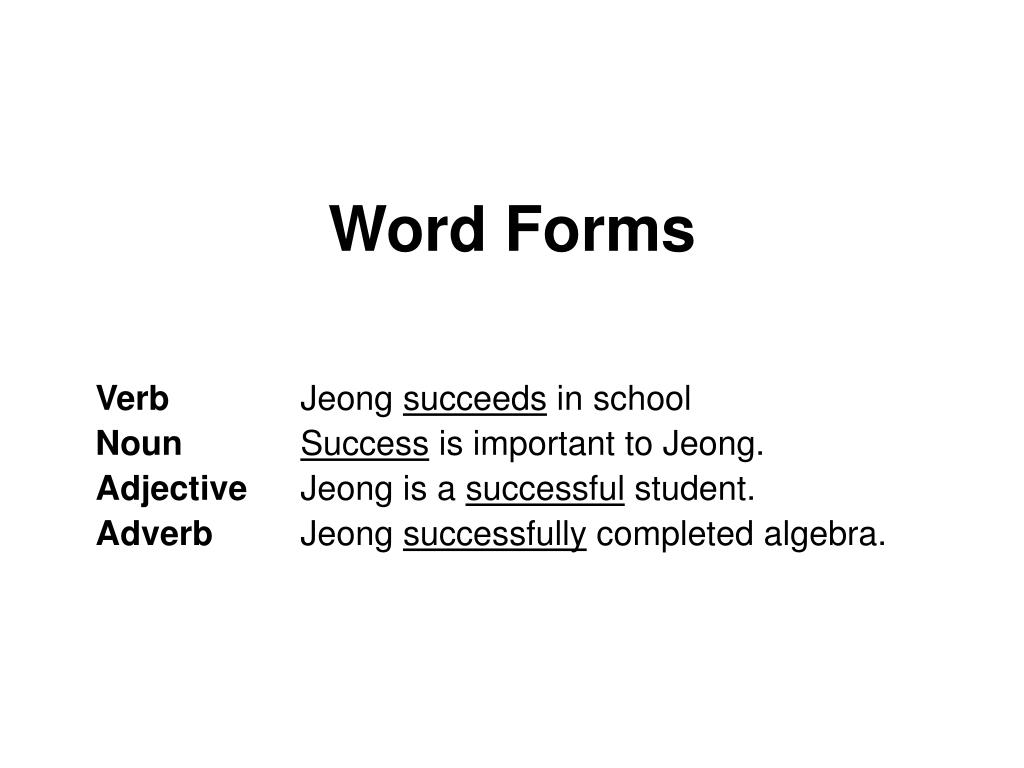Back to: ENGLISH LANGUAGE SS2
Welcome to class!
In today’s class, we will be talking about word forms, informal letter and writing exposition. Enjoy the class!
Word Forms, Informal Letter and Writing Exposition

WORD FORMS
In English Language, we generate new words by adding some letters to the original word. This addition of letters could be at the initial or the final state of the original word. Word form is simply the process of generating new words or converting words from one-word class to another.
Many words in the English language can function as noun, verb, adverb and adjective. It is possible to convert verb to noun, noun to adjective, adjective to a noun, and so on. For instance, the word ‘happy’ is an adjective but it can also function as a noun when you add the suffix‘-ness’, after which it becomes ‘Happiness’ (a noun)
More examples include benefit, beneficial and beneficially; beauty, beautify, beautiful and beautifully.
Words can also change for reasons related to tense i.e. from singular to plural form, and also from the base form to –ing or en/ed form. For instance, create, creates and creating; go, goes, going and gone.
How we form words in English Language
We form words primarily through a process called affixation, a process of adding to words either at the initial or final state. Affixation can be achieved through prefixation or suffixation.
Prefixes are letters we add to the beginning of words to make new words with different meanings. Prefixes can, for example, create a new word opposite in meaning to the word the prefix is attached to. They can also make a word negative or express relations of time, place or manner. Examples are im, out, im, down, un, mega, over, auto, dis, etc. Check the following examples.
Im + possible = impossible
Un + able = unable
Over + cook =
Auto + biography = autobiography
Dis + agree = disagree
Down + grade = downgrade
Mega + byte = megabyte
Mid + day = midday
Out + do = outdo
Suffixes
Suffixes unlike prefixes come after the original word. Suffix on its own can change the word from its original word class to another. Examples of suffixes are ness, er, ly, age, all, ment, or, tion, city, ful, ist, ify, able, ish, ive, ic and ous.
Let’s consider some examples:
happy + ness = happiness
simply + fy = simplify
use + ful = useful
attract + ive = attractive
music + al = musical
kind + ness = kindness
act + or = actor
describe+ ive = descriptive
Evaluation
- Look for five new prefixes and join them with appropriate words to form new words.
- Look for ten new suffixes and join them with appropriate words to form new words.
INFORMAL LETTERS
It is ironical to see that as easy as informal letters may appear to be, many people do not know how to write interesting and heartfelt letters.
Strategy
Informal letters, otherwise known as personal letters are written for an intended exchange of intimate ideas.
Informal letters are letters written to relatives, friends and loved ones. The language is expected to be free, accommodating and simplified.
Put the following to mind:
- Informal letters, unlike formal letters, are expected to have just one address.
- The date comes after the address.
- The salutation always contains the recipient’s first name or title, with an option of ‘Dear’ or ‘My dear’ before the name: My dear Bola, Dear Bola, Dear Teacher, Dear Mummy, Dear Uncle, Dear Miss, etc.
- The body of the letter should be written in paragraphs.
- Then the salutation.
Evaluation
Write a letter to your sister schooling abroad telling her how you have been studying at home despite the Coronavirus lockdown and imploring her to stay safe by all means.
EXPOSITORY ESSAY
An exposition essay, as its name implies, is the act of exposing or putting something out to the public view through writing. They are otherwise known as informative writings.
The source of your exposition can be based on your personal view, observation, experience or research on something you will like to make known to the public.
Some certain features of exposition are noteworthy here.
- The title.
The title should be able to inform the reader instantly what they are about to read in the text.
- Introduction.
Here, is where the topic of the exposition is been introduced by providing an overview of what the essay is about. It may also preview each major section ahead indicating what aspects of the subject will be covered in the writing.
- The Body of the Text.
This comes in paragraphs, and each paragraph deals with one idea or piece of information. The structure for writing one can be as follow:
- Definition
- How to do something.
- Cause/effect
- Comparison/contrast
- Explaining the process
- Problem/solution
- Classification
- Whatever has a beginning has an end. Your conclusion should summarize the topic under discussion, with probable reference to the body of your essay or general information that will cause the reader to keep remembering your essay even after a long time.
If you begin by considering the points above as important, you will be able to write beautiful expository essays.
General Evaluation
Write an essay on the title ‘The danger of throwing a party during the Coronavirus outbreak.’
In our next class, we will be talking about Diphthongs, Determiners and Writing Skills. We hope you enjoyed the class.
Should you have any further question, feel free to ask in the comment section below and trust us to respond as soon as possible.
